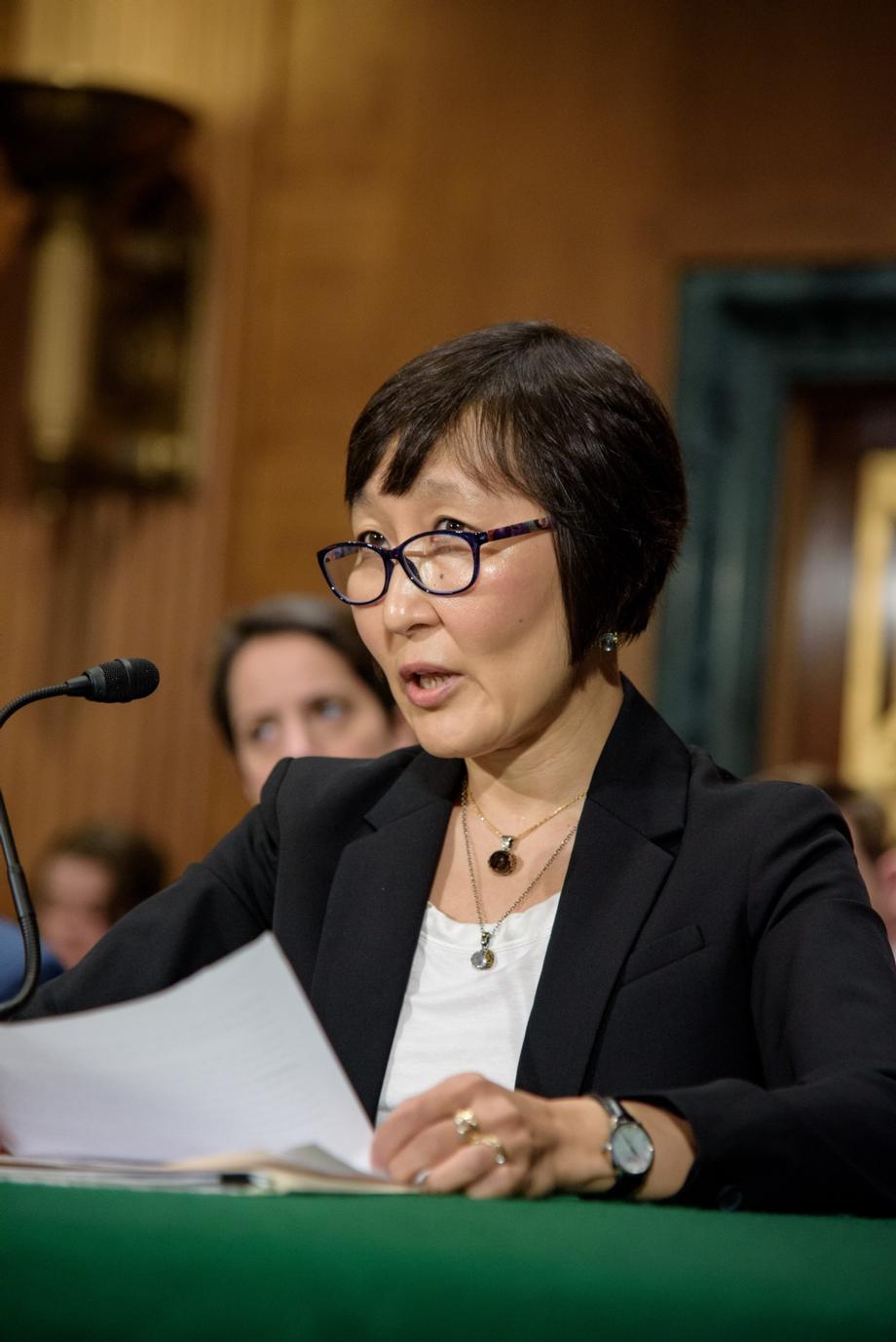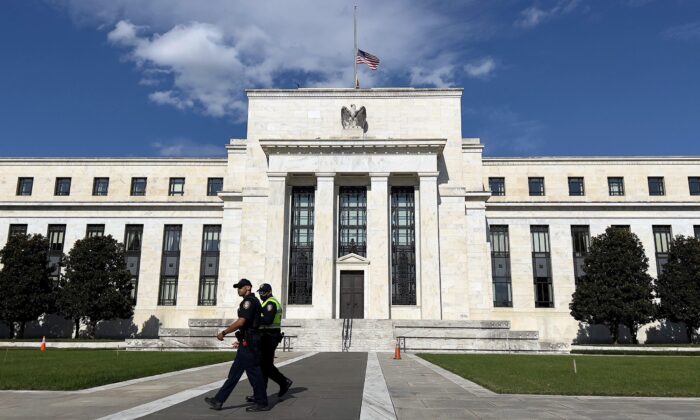In Saule Omarova’s world, America only really needs one bank—the Federal Reserve. Omarova, President Joe Biden’s nominee to be one of the top banking regulators, has proposed such drastic expansion of government control over finance that it’s leaving some experts scratching their heads over whether the administration is serious about her nomination.
A descendant of Kazakh intellectuals who were persecuted by the Soviet regime, Omarova saw firsthand the effects of a tyrannical state. However, that doesn’t appear to have tempered her vision of expanding the power of the state in America.
It would be best, she outlined in a series of articles and papers, to virtually abolish private banking. Every American would have a bank account set up at the Fed and authorities would be free to inflate the currency by issuing interest on the deposits or even crediting the accounts directly. To counter inflation, the Fed could also slash interest rates or even, if all else fails, take away people’s money as needed, she proposed in a recent paper (pdf).

However, she didn’t stop there. The Fed would build a stock portfolio mirroring the broader market and short stocks it perceives as inflated in value or “go long” on those it sees as undervalued. The government also would be given special voting rights as though it were a major shareholder in every publicly traded company, directly influencing the appointment and firing of executives.
According to several experts, the implications of the first proposal alone—the centralization of banking—are so enormous they would effectively enable the government to run the economy with near-unlimited discretion.
Omarova didn’t respond to emailed questions and a request for an interview.
Who Lends to Whom?
“If you have all of the deposits in the government bank, then all of the loans, or at least a very high percentage of the loans, are going to be there as well,” said Alex Pollock, former head of the Federal Home Loan Bank of Chicago and financial research executive at the Treasury who is currently a senior fellow at the classical liberal Mises Institute.
Controlling credit means the Fed—and de facto the federal government—would have a say in most major individual economic decisions, such as what factory or office tower gets built, who gets to build or buy a home, and even who gets to go to college or buy a car.
“If you’re politically correct, well, then you can get a loan; if you’re not, you can’t,” Pollock told The Epoch Times about the implications.
Omarova argued the government wouldn’t necessarily make such detailed decisions, but would lend money to “qualifying lending institutions” (QLI) at “affordably priced” interest rates and those QLIs would then relend it to individual customers and pocket the difference in interest. Their pecuniary interest would thus lead them to lend only to financially sound projects.
Then what would stop a QLI from borrowing from the Fed excessively? Omarova would require them to pledge collateral for the money borrowed. Only “quality” collateral would pass, such as government bonds and various high-rated debt securities. Issuing “quality” loans would thus enable a QLI to borrow more from the Fed to make more loans, etc. As such, QLIs would be strongly incentivized to only make loans and investments that could pass as collateral with the Fed.
Omarova acknowledges how major “the impact of the Fed’s collateral eligibility policies on the economy-wide credit allocation” would be.
Government officials setting such criteria would thus pull many a string of the economy at large.
“She wants government to control the allocation of capital in the economy, which is a recipe for politicizing everything,” said David Burton, financial regulation expert at the conservative Heritage Foundation.
Pollock concurred: “It would become purely political.”
Omarova seemed to affirm the influence of political priorities. The Fed would be “explicitly preferencing certain categories of assets” such as “loans to small and medium-size non-financial enterprises and minority-owned businesses, student loans, credit supporting development in underserved communities” and others, she wrote.
Meanwhile, the central bank would reject some assets such as “private equity bridge loans, highly engineered asset-backed securities,” etc., and even ban QLIs from using Fed money for certain loans, such as “loans fueling secondary-market financial speculation, leveraged buyouts (‘LBOs’), massive stock buybacks” etc., she wrote.
Who would have the power to approve QLIs? The federal comptroller of the currency at the Treasury Department—exactly the role Omarova was nominated for.
While her focus is mainly on suppressing what she sees as maladies of the financial market, the Biden administration has made clear it wants financial regulators to target a much broader set of priorities, including steering capital toward companies it sees as furthering the climate-change agenda and away from those that don’t.
In Omarova’s proposal, the Fed wouldn’t have to bother financing political priorities through private parties. It would create a National Investment Authority (NIA) to funnel money from the Fed into “publicly beneficial infrastructure projects.” The NIA would set up investment funds to finance projects such as “nationwide clean energy networks and high-speed railroads, regional air and water cleaning and preservation programs, systems of ongoing adult education and technical training, networks of mixed public-private ‘startup’ finance funds, and so on,” she wrote.
While she noted that such projects don’t necessarily “generate easily privately ‘capturable’ revenues,” private parties putting money into such funds would still reap “rewards,” she wrote. Where would the rewards come from? The Fed would come up with them through “advanced financial engineering,” she argued.
The Fed wouldn’t need private investors, she wrote. They would be invited only so they have something “productive” to do with their money and also to incorporate “price signals” into the NIA’s investment decisions.
It isn’t clear what such price signals would be worth when the investors would be limited to options predetermined by the NIA, Pollock noted.
In fact, it isn’t clear how the Fed would determine what is or isn’t productive in a system in which credit flows are largely determined by the government. The ordinarily robust private credit to serve as a frame of reference would be largely absent and so the Fed would have to fall back on its own judgment.
“Nobody, especially a government bureaucracy, can know enough to do this,” Pollock commented in an email. “It is a totally naïve and, in fact, silly idea.”
At times, Omarova contrasted “productive” investment with speculative investment, which she called “misallocation of capital.”
But speculation “can be destabilizing or stabilizing,” Pollock said. Suppressing it by government mandate doesn’t necessarily heal the monetary woes. In fact, the current practice of the Fed buying up securities seen as safe, like government bonds and mortgage-backed securities, depresses yields on such instruments and pushes investors toward riskier assets, he said.
Omarova argued that something like the NIA has worked before, giving the example of the New Deal-era Reconstruction Finance Corp. (RFC). She didn’t mention the demise of the agency in 1953 after a litany of corruption and scandals.
“According to a Senate investigation of 1951, securing an RFC loan through the Democratic National Committee had become a common practice,” Clark Nardinelli noted in a paper for the Heritage Foundation in 1983.
It’s not clear how Omarova would control corruption within the system she envisions.
Pollock estimated that such an all-powerful Fed “would go on inflating the money supply by lending to the government itself (monetizing government debt) and to politically favored entities of all sorts.”
‘Faith and Credit’
Omarova portrays her vision as the “democratization” of banking. In her view, the Fed functions as a “franchisor,” issuing franchises in the form of charters to its member banks. The Fed is, in turn, controlled by the federal government, which is run by politicians, who are elected by the public.
“The Fed acts on behalf of the sovereign public as the ultimate creator of a unique collective good: the monetized full faith and credit of the United States,” she summarized.
According to Pollock and several other economists, there are a number of problems with this view.
First off, the “faith and credit of the United States” simply means the ability of the federal government to capture a portion of the productivity of the American people in the form of taxes. If Americans aren’t sufficiently productive or if the government loses its ability to sufficiently tax, the “faith and credit” disappears too.
To portray this asset as a “collective good” is problematic because not everyone is contributing to it equally. People run the gamut from extraordinarily productive to utterly unproductive.
Moreover, in practice, the Fed only partly operates as a government-run franchisor. It is also controlled by the member banks who follow their own interests. After the 2008 crash, the Fed extended over $29 trillion in mostly short-term loans to various financial institutions (many of them foreign), in what critics called a bailout of the big banks. At the same time, the bailout also served a political purpose for the government as it, at least on its face, served to save the jobs and savings of millions of voters.
Omarova cited Fed’s interventions in the market to conclude that such measures are the normal and necessary job of a “modern central bank.” As such, the bank could intervene even more and do so more efficiently if it controls the financial industry outright.
The problem is, many experts argue that the Fed’s interventions simply delay the inevitable market correction the economy will eventually have to undergo. The more it’s delayed, the worse it will be. The Fed simply kicks the can down the frosty road of finance, watching it snowball.
“In my view, the Federal Reserve already intervenes too much. Making it the monopoly deposit taker and dominant lender would certainly create an inefficient federal bureaucracy,” Pollock said. “Just look how well student loans have turned out.”
Omarova’s ideas about redistributing the “monetized full faith and credit of the United States” raise the question of how much faith and credit the country has left.
Current federal debt stands at over $28 trillion and nearly 130 percent of the GDP. With consumer prices up nearly 7 percent up over the past two years, there’s a worry that excessive money printing could trigger runaway inflation.
There seems to be an air of suspense regarding the U.S. monetary system, which de facto undergirds financial markets worldwide. Increased spending on durable goods, jewelry, guns, and ammunition as well as the growing popularity of “prepping” hint at the level public anxiety toward the American economy as a whole.
If that should deter the government from further pushing its intervention in the economy, it may actually do the opposite.
If a financial crisis were to hit, the government could usher in Omarova’s proposals as a supposed solution, positioning itself as the savior, according to Mark Thornton, economist at the Mises Institute.
“It sure seems like they know how much the Fed has really messed up the structure of the economy and financial system and they are getting ready for high price inflation, bank runs and failures, and a stock market crash,” he said.
“They always want to manage the message that they solve problems, rather than cause them, and in this case, it is clear that they have brought about these problems with a decade-plus of ultra-low interest rate policy.”
Tools to counter inflation make up a significant part of Omarova’s proposals, particularly her idea of “draining liquidity” directly from people’s bank accounts.
This method, however, isn’t exactly new, Pollock said. It’s been the hallmark of socialist regimes.
One good example, he noted, is the Communist Party of Czechoslovakia’s “Monetary Reform” in 1953.
After World War II, the economy of the Eastern European country was weak and as the Soviet-backed regime gradually took over, it redirected massive investments toward the military and heavy industry. That exacerbated a shortage of consumer goods—people had nowhere to spend the money they managed to save up during and after the war.
Despite strict cash withdrawal limits and rationing, consumer goods prices went through the roof, especially in the open market, where one needed to go after running out of rations. A bag of rice was about 13 times more expensive in the controlled market and nearly 100 times more in the open market in 1952 than before the war. The regime then decided to curb inflation by draining liquidity.
On May 30, 1953, the regime announced that the old currency would expire the next day and would be exchanged for a new currency. The exchange rate was drastically “progressive.” Small cash amounts of old currency and small deposits were exchanged at a rate of 5 “old” for 1 “new.” Large deposits had a rate of 30-to-1 and larger cash amounts 50-to-1.
In effect, the populace was stripped of its savings. The move pushed back inflation, but decimated people’s trust in the monetary system. It also created massive opportunities for corruption. Communist officials were known to get better exchange rates than commoners. Some knew about the move in advance and could prepare accordingly. Rumors about the incoming “reform” were quashed by the authorities as malicious misinformation. Those who were most trusting and loyal to the regime thus ended up being hurt the most.
Omarova would alleviate people’s worries about the government suddenly taking money from their accounts by keeping physical cash in circulation and also giving “as much advance warning as possible” before any draining commences, she wrote.
In that case, it seems, people could simply withdraw their money the day before the “draining” and deposit it back the day after. Omarova didn’t explain how the Fed would prevent that from happening.
Many such questions appear to be left unanswered, often explicitly left to be figured out in “the implementation phase.”
It’s true that her vision would make the banking sector much simpler. Pollock says it’s “dubious,” however, whether that would lead to greater efficiency.
“Once the government takes control of everything, it generally doesn’t get more efficient.”
Correction: A previous version of this article incorrectly identified current affiliation of Alex Pollock. He is a senior fellow at the Mises Institute.

